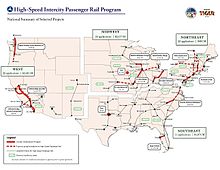 | |
| Long title | An act to develop a national intermodal surface transportation system, to authorize funds for construction of highways, for highway safety programs, and for mass transit programs, and for other purposes |
|---|---|
| Acronyms (colloquial) | ISTEA |
| Nicknames | Ice Tea |
| Enacted by | the 102nd United States Congress |
| Citations | |
| Public law | Pub. L. 102–240 |
| Statutes at Large | 105 Stat. 1914 |
| Codification | |
| Titles amended | |
| Legislative history | |
| |
| Major amendments | |
| I-27 Numbering Act of 2023 | |
The Intermodal Surface Transportation Efficiency Act of 1991 (ISTEA, /aɪsˈti/) is a United States federal law that posed a major change to transportation planning and policy, as the first U.S. federal legislation on the subject in the post-Interstate Highway System era.
The act was signed into law on December 18, 1991, by President George H. W. Bush and codified as Pub. L. 102–240 and 105 Stat. 1914. The bill was preceded by the Surface Transportation and Uniform Relocation Assistance Act in 1987 and followed by the Transportation Equity Act for the 21st Century (TEA-21) in 1998, the Safe, Accountable, Flexible, Efficient Transportation Equity Act: A Legacy for Users (SAFETEA-LU) in 2005, the Moving Ahead for Progress in the 21st Century Act (MAP-21) in 2012, the Fixing America's Surface Transportation Act (FAST) in 2015, and the Infrastructure Investment and Jobs Act in 2021.
Objective
The act presented an overall intermodal approach to highway and transit funding with collaborative planning requirements, giving significant additional powers to metropolitan planning organizations (MPOs).
ISTEA also provided funds for the conversion of dormant railroad corridors into rail trails; the first rail trail to be funded was the Cedar Lake Regional Rail Trail, in Minneapolis, Minnesota.
High priority corridors
Section 1105 of the act also defines a number of High Priority Corridors, to be part of the National Highway System. After various amendments in subsequent transportation bills and other legislation, this is a list of the corridors:
High-speed rail corridors

The legislation also called for the designation of up to five high-speed rail corridors. The options were studied for several months, and announced in October 1992. The first four were announced by United States Secretary of Transportation Andrew Card, while the last was announced by Federal Railroad Administration head Gil Carmichael.
- October 15, 1992: The Midwest high-speed rail corridor with three links from Chicago, Illinois to Detroit, Michigan, St. Louis, Missouri, and Milwaukee, Wisconsin.
- October 16, 1992: The Florida high-speed rail corridor linking Miami with Orlando and Tampa.
- October 19, 1992: The California high-speed rail corridor linking San Diego and Los Angeles with the San Francisco Bay Area and Sacramento via the San Joaquin Valley.
- October 20, 1992: The Southeast high-speed rail corridor connecting Charlotte, North Carolina, Richmond, Virginia, and Washington, D.C.
- October 20, 1992: The Pacific Northwest high-speed rail corridor linking Eugene and Portland, Oregon with Seattle, Washington and Vancouver, British Columbia, Canada.
There was not significant funding attached to these announcements: $30 million had been allocated to several states by 1997 to improve grade crossings, but that was a very tiny amount in comparison to the billions required for a true high-speed network. Aside from a few places in California and the Chicago–Detroit Line, most areas outside the Northeast Corridor continued to be limited to 79 mph (127 km/h) until $8 billion from the American Recovery and Reinvestment Act of 2009 was distributed in January 2010.
Jeff Morales one of the principal drafters of this bill, served as CEO of the California High-Speed Rail Authority, which is currently constructing a high-speed rail line along the route originally proposed in this bill, from 2012 to 2017.
Airbags
The Intermodal Surface Transportation Efficiency Act of 1991 also mandated that passenger automobiles and light trucks built after September 1, 1998, to have airbags installed as standard equipment for the driver and the right front passenger.
Notes
- Section 1105 did not amend the U.S. Code, nor is it editorially classified as part of the U.S. Code, or set out as a statutory note to a section of the U.S. Code. However, an up-to-date version of ISTEA as amended can be found at govinfo.gov
- I-70 does not come near Salt Lake City; instead terminating 173 miles (278 km) south of such city at I-15. Regardless, the law states "Interstate Route 70 from Denver, Colorado, to Salt Lake City, Utah"
- The law's text states, "The Oregon 99W Newberg-Dundee Bypass Route between Newberg, Oregon and Dayton, Oregon;" however, the actual route number is Oregon Route 18. The bypass runs east of Oregon Rte. 99W. The southern portion, Phase 1, between Rte. 99W at Dundee and Rte. 219 is finished. Sufficient funding for the northern portion, Phase 2, which is from Rte. 219 to Rte. 99W, has not yet been identified.
References
- "United States Code". Office of the Law Revision Counsel. Retrieved December 30, 2021.
- "Statute Compilations". Government Printing Office. Retrieved May 5, 2020.
- ^ "Intermodal Surface Transportation Efficiency Act of 1991, as Amended, §1105". U.S. Government Printing Office. Retrieved December 30, 2021.
- "High Priority Corridors - National Highway System - Planning". Federal Highway Administration. October 2012. Retrieved October 31, 2021.
- ^ Appalachian Regional Commission. "Status of the Appalachian Development Highway System as of September 30, 2019" (PDF). Appalachian Regional Commission. Retrieved December 12, 2020.
- ^ Appalachian Regional Commission. "Status of the Appalachian Development Highway System as of September 30, 2017" (PDF). Appalachian Regional Commission. Archived from the original (PDF) on July 4, 2020. Retrieved July 3, 2020.
- ^ Appalachian Regional Commission. "ADHS Approved Corridors and Termini as of 2018" (PDF). Appalachian Regional Commission. Archived from the original on June 10, 2016. Retrieved July 3, 2020.
- "AASHTO Electronic Balloting System - View Ballot - Agenda and List of Applications SM-2016" (PDF). AASHTO. Archived from the original (PDF) on June 10, 2016. Retrieved May 5, 2016.
- "OR 18: Newberg Dundee Bypass Phase 2 Design Phase". Oregon Department of Transportation. Retrieved June 7, 2020.
- Oregon Department of Transportation. "Bypass Opened January 6, 2018". Oregon Department of Transportation. Retrieved June 7, 2020.
- "Chronology of High-Speed Rail Corridors". Federal Railroad Administration, Department of Transportation. July 7, 2007. Archived from the original on November 30, 2009. Retrieved March 16, 2014.
- "High Speed Ground Transportation for America - CFS Report To Congress". Federal Railroad Administration. September 1997. Archived from the original on August 25, 2009. Retrieved March 16, 2014.
- Rosenberg, Zach (February 1, 2010). "At Long Last, Clear Messages for High-Speed Rail". Wired Blogs. Retrieved March 16, 2014.
- The Registry-San Francisco (May 29, 2012). "California High-Speed Rail Authority Hires World Recognized CEO". Retrieved October 31, 2021.
- Office of Research and Development (June 21, 2001). "Air Bag Technology in Light Passenger Vehicles" (PDF). U.S. NHTSA. p. 1. Archived from the original (PDF) on December 15, 2014. Retrieved March 16, 2014.
- "Sep 1, 1998: Federal legislation makes airbags mandatory". history.com. Retrieved March 16, 2014.
External links
- Intermodal Surface Transportation Efficiency Act of 1991 as amended (PDF/details) in the GPO Statute Compilations collection
- Intermodal Surface Transportation Efficiency Act of 1991 as enacted (details) in the US Statutes at Large
- H.R. 2950 on Congress.gov
- S. 1204 on Congress.gov
- A Guide to Metropolitan Transportation Planning Under ISTEA - How the Pieces Fit Together (USDOT) Archived April 8, 2005, at the Wayback Machine
- "Statutory Listing of Priority Corridors - High Priority Corridors". Federal Highway Administration. Retrieved May 5, 2020.
- "FHWA - NHS High Priority Corridors". Federal Highway Administration - United States Department of Transportation. September 1996. Archived from the original on April 10, 2007. Retrieved March 16, 2014.
| United States federal transportation legislation | |
|---|---|
| Federal aid highway acts | |
| Surface transportation assistance acts |
|
| Public transit | |
| Related | |

